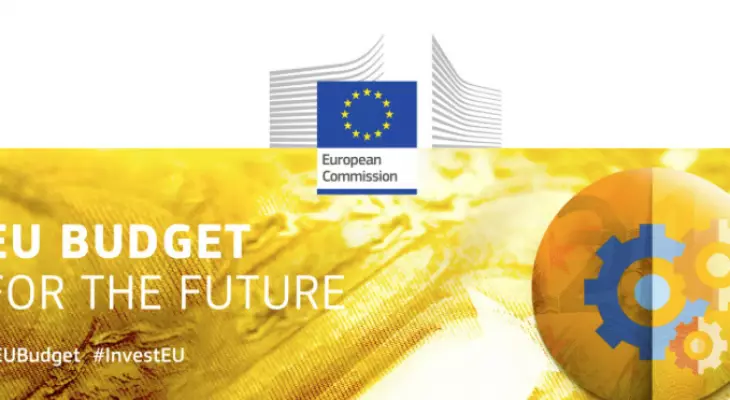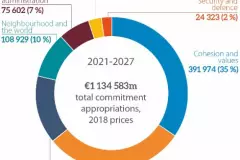The Making of the Multiannual Financial Framework 2021 - 2027
With the end of the 2014 - 2020 funding period, the European Union (EU), its citizens and its institutions looked expectantly to Brussels to see how the final steps of the negotiation process for the new Multiannual Financial Framework (MFF) would go. In 2020, the negotiations were definitely going to be very tight this time. An agreement had to be reached by December 31 if the start of the new period was not to be postponed. In the end, the most important questions were: Will the budget for the next seven years be passed on time? Or will there be too many hurdles, such as vetoes or bureaucratic delays, which could lead to a backlog of EU funds? And what would happen then?
Fortunately, in the end, the financial framework was passed narrowly but on time. You can find all the background information here in this article.
What exactly is the Multiannual Financial Framework - MFF for short?
The MFF is not equal to the EU budget. It rather sets the priorities for EU financial planning. In other words, the MFF specifies in which areas the EU intends to invest and how much within a time period of seven years. It is thus primarily an expression of the political priorities.
The annual EU budget is adopted in accordance with the requirements of the MFF. Following the European Commission implements the budget in cooperation with the member states and under the supervision of the European Parliament.
Why does the EU need a Multiannual Financial Framework?
The MFF is intended to establish budgetary discipline and ensure that EU spending remains predictable. With a duration of seven years, there is sufficient time to see whether the joint measures are having an impact. This long-term perspective is particularly important for potential recipients of EU funding or authorities which are involved in financing projects.
What is the coordination process usually like?
It takes several years for a new MFF to be agreed on by all the member states. The process begins with the European Commission presenting the package for the MFF. For the period of 2021 to 2027, the Commission presented its initial proposal in May 2018. In addition to the MFF Regulation, the package also included the draft Own Resources Decision, a legislative act on how the EU Budget is financed (find more information here).
In a second step, the General Affairs Council, consisting of all member states´ foreign ministers, discusses the package. The foreign ministers work out which political guidelines the EU should pursue over the term of the next MFF. The recommended priorities then go to the European Council as a basis for negotiation. Here, the heads of state and government discuss the contents of the MFF regulation. It is important to mention that they have to adopt the final version unanimously, if one member state puts forward a veto the negotiations fail. The stakes are high!
The next step is for the European Parliament to give its opinion on the regulation. It has two options for action: it can either accept or reject it by a majority, but it cannot make any changes itself. In the final step, the member states must ratify the MFF, i.e. recognize the regulation as binding.
What was different this time around?
Whilst the Commission represents the EU as a whole, the Parliament represents the Citizens, both started the negotiations for the MFF 2021 - 2027 with very high budget expectations. After the reality of the Brexit dropout in 2018 and the consequential gap in the EU´s budget, the EU wanted to present strength and stability. So instead of having a smaller budget with its second biggest EU net contributors gone, they all agreed on enlarging it. Especially programmes such as Horizon Europe, Erasmus+ and “Citizens, Equality, Rights and Values” that specifically promote European values were promised a larger budget.
However, the heads of government, who are responsible for filling the EU budget, argued for a smaller budget than expected by the Parliament. These disputes between Parliament and Council come up every time during the MFF negotiations and are almost considered a tradition.
The impact of CoVID19
With Corona hitting the EU in March 2020 the heads of state and government agreed that an extraordinary effort was needed to support the European economy in the face of the historically unprecedented and unlevered crisis. This is why, in spring 2020, they agreed on throwing some pieces of the preceding negotiations overboard to re-prioritize and create a budget that would be able to lead Europe out of the crisis. In May the Commission prepared a package, which was accepted by the Parliament and passed onto the heads of state and government at the European Council. After four days of deliberations, they agreed on a MFF of 1,07 trillion euros plus a recovery fond of 750 billion euro. From 2021 to 2023, these 750 billion euro, split into grants and loans, are to be made available for a reconstruction fund to deal with the economic consequences of the Corona pandemic.
You might think this would be the end of the story … but no. The Parliament further pushed for the introduction of a rule of law mechanism anchored in the MFF regulations and claimed to veto any budget without such a mechanism. The mechanism is supposed to introduce binding conditions in order to receive money. That way further breaches of EU values and treaties shall be prevented. Particularly, the member states Poland and Hungary threatened to veto the proposal in the Council, because the feared that the mechanism would disadvantage them.
Nonetheless, we have eventually reached a happy ending. On December 11 the member states came to an agreement with a final budget of 1.086.800.000€ plus 750.000.000.000€. This can now be presented for a vote to all the remaining institutions, inviting Parliament and Council to take the necessary steps for the adoption of the package.
In a nutshell…
Timeline of the Multiannual Financial Framework 2021 - 2027:
- March 2018: Parliament suggests 325.100.000.000€ (Focus on Research, Education and Exchange, Climate and Energy)
- May 2018: EU Commission officially announces 135.089.000.000€ (Focus on Research, Investment, Migration and Border Security), also introducing a rule of law mechanism in it
- October 2019: EU Council reduces the budget draft to 087.000.000.000€ (Cuts in Horizon, Erasmus and Defense)
- May 2020: EU Commission presents a new budget of 100.500.000.000€ with adaptations to the corona crisis
- July 2020: EU-Council agrees on a corona budget 074.300.000.000€ with further cuts, but adds a new recovery fund of 750.000.000.000€
- November 2020: EU-Council and Parliament negotiators settle the EU Parliaments demands with a 15.000.000.000€ top-up for some of the flagships programmes and a strengthened rule of law mechanism
- December 2020: EU-Council agrees unanimously to the budget of now 086.800.000€ + 750.000.000.000€
Blogartikel zu Own Resources Decision








